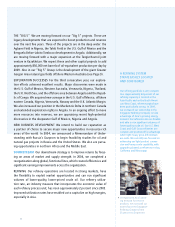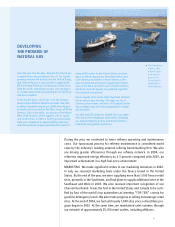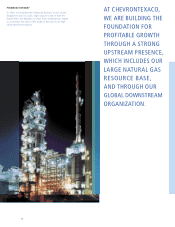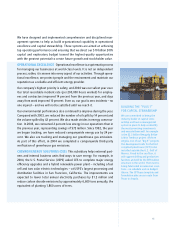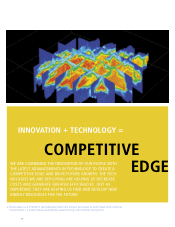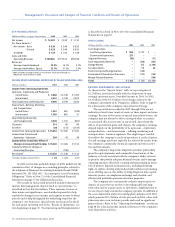Chevron 2004 Annual Report Download - page 19
Download and view the complete annual report
Please find page 19 of the 2004 Chevron annual report below. You can navigate through the pages in the report by either clicking on the pages listed below, or by using the keyword search tool below to find specific information within the annual report.
17
ChevronTexaco has built a technology organization that is unique in our
industry. It is the only one that is fully integrated and capable of delivering
technology and services throughout the energy value chain. Our technology
strategy also is partner-driven. We have forged alliances to share technical
risk, cost and talent with external organizations that have complementary
capabilities. Our technology group not only supports the strategies of our
core businesses, but also is engaged in developing technology to enable
our most promising opportunities.
In upstream, we are deploying technology to help
select exploration prospects with ever-greater precision and drill them with
minimum impact on the environment. Our proprietary seismic technology
has led to a series of major discoveries in recent years, particularly in deep
water. In 2004, our exploratory success rate was 57 percent, well above the
10-year industry average of 32 percent.
Technology also is supporting major petroleum developments. One example
is the Tengizchevroil (TCO) sour gas injection project in Kazakhstan. In 2004,
TCO completed the design of the world’s largest single train sulfur-recovery
unit and significantly advanced gas-injection technology. In another effort,
we are developing a next-generation reservoir simulator with an industry
partner. The simulator will improve the speed and accuracy of modeling
large, complex reservoirs and estimating their reserves.
Additionally, technology is playing an important role as we commercial-
ize our large natural gas resources. Efforts are under way to improve the
construction of liquefied natural gas (LNG) facilities, reduce LNG storage
costs and enhance regasification processes. The Sasol Chevron gas-to-liquids
(GTL) joint venture will be applying some of the most advanced GTL tech-
nologies to projects in progress in Nigeria and Qatar.
In downstream, we are deploying catalyst technologies and making
advanced fuels for our customers. As part of this effort, we continue to
improve our ability to convert extra-heavy oil into high-value, light petro-
leum products. Additionally, we are investing in technology to produce
lubricant additives that use sulfur-free GTL base stocks.
We partner with academic, business and public-sector
organizations to create and deploy effective, cost-efficient technologies.
In 2004, we established a new Center of Research Excellence at the Uni-
versity of Southern California to develop next-generation digital oil-field
technologies. Centers focused on other research have been established at
the University of Tulsa and Colorado School of Mines.
PRACTICAL HYDROGEN –
CREATING FUTURE
FUEL OPTIONS
As energy demand continues to
grow, ChevronTexaco is pursuing
next-generation fuels, includ-
ing hydrogen. In 2004, the U.S.
Department of Energy selected
ChevronTexaco to lead a consortium
that will demonstrate hydrogen
infrastructure and fuel-cell vehicles.
Over a five-year period, the consor-
tium will build up to six hydrogen
energy service stations with fueling
facilities for small fleets of fuel-cell
vehicles and capacity to generate
high-quality electrical power from
stationary fuel cells.
> Above: A hydrogen fuel cell unit at our San Ramon, California, headquarters is the primary power source
for a data center. Shown here (left to right), ChevronTexaco Technology Ventures’ Jeffrey Jacobs and Ed
Wisler. > Below: The first of up to six U.S. hydrogen energy service stations opened in 2005 in Chino, California.



